Physical Address
304 North Cardinal St.
Dorchester Center, MA 02124
The face is the focus of social interaction, and therefore facial abnormalities have a significant impact both in psychological and emotional terms. Facial abnormalities are often associated with other anomalies and may be a clue to the detection of chromosomal disease or a more complex syndrome. This has practical implications in terms of need for invasive tests to identify karyotype and genetic counselling. The detection of isolated facial anomalies is also important as the parents then have time to prepare themselves for the abnormality and can be counselled by paediatric and plastic surgeons as to the treatment options and long-term outlook for the baby.
It is important, therefore, to make as precise a diagnosis as possible in order to give parents a clear picture of the abnormality. In this respect, the introduction of 3D imaging may well have an impact not only for improving the parents' understanding of the defect, but also to give paediatric surgeons a clearer assessment of the problem.
In the UK, routine ultrasound screening is offered to all pregnant women at 20 weeks' gestation and examination of the face with a view to exclude cleft lip is an integral part of the fetal anomaly screening programme. Detection rates for fetal facial abnormalities vary however: reported series range from 17.5% to 75% in the low-risk population. Detection rates in a high-risk population are difficult to assess: Pilu et al detected 12 out of 14 cases of facial malformation in 223 patients at high risk for carrying fetuses with craniofacial malformations.
The embryology of the face is a complex process but knowledge of embryology is useful in understanding some of the facial abnormalities, in particular facial clefting.
The human face is formed between the 4th and 10th week of pregnancy by the fusion of five facial swellings, an unpaired frontonasal process, a pair of maxillary swellings and a pair of mandibular swellings ( Figure 13-1A ). The maxillary and mandibular swellings constitute dorsal and ventral regions respectively of the first pharyngeal arch, and give rise to the upper and lower jaws.
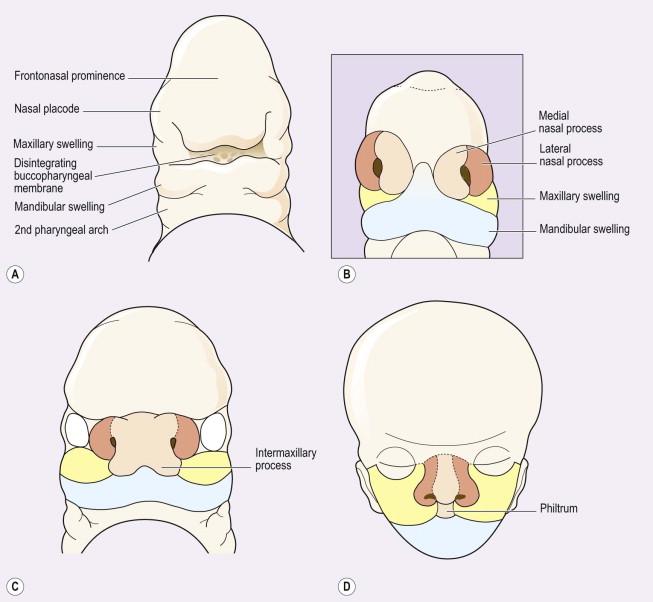
During the 5th week two swellings appear on the frontonasal process, which form the medial and lateral nasal processes ( Figure 13-1B ). In the 6th week the two medial nasal swellings migrate medially and by the 7th week fuse to form the central portion of the nose, the lateral nasal processes form the nostrils. The maxillary swellings also migrate medially so that by the 10th week they have fused in the midline to form the philtrum of the upper lip and the primary (anterior) palate ( Figure 13-1C and D ).
The posterior or secondary palate forms from two thin soft tissue bands that arise from the medial walls of the maxillary swellings, termed the palatine shelves. These two palatine shelves appear during the 8th and 9th week and grow medially to fuse in the midline at approximately 10 weeks. Fusion commences anteriorly and progresses posteriorly ( Figure 13-2A ) to form the secondary palate. During the same period, growth of the nasal septum separates the left and right nasal passages ( Figure 13-2B ).

The eyes first appear in the 4th week in the form of a pair of lateral grooves, the optic sulci, which grow out from the primitive forebrain to reach the surface ectoderm to form the optic vesicle ( Figure 13-3 ). The optic vesicle differentiates into the optic cup and lens, so that by the 8th week the basic structure of the eye is established. The developing lens is supplied by the hyaloid artery, which is the terminal branch of the ophthalmic artery. The portion of the artery that crosses the vitreous degenerates at the end of the second trimester, and the remainder of the artery forms the central artery of the retina. The eyelids form at about 8 weeks and remain fused until approximately 20 weeks. The orbits form around the developing eye from the hypophyseal cartilages and the greater and lesser wings of the sphenoid.
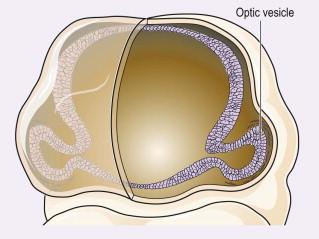
The ear has a complex embryology with the external and middle ears arising from the first and second pharyngeal arches, whereas the inner ear develops from an epidermal tissue mass, the otic placode, which appears during the 3rd week. Development of the inner and middle ear is complete by the 8th week. The pinna of the ear is formed from six auricular swellings, which appear at 6 weeks and fuse by approximately 10 weeks. Therefore by 10 weeks the basic structure of the face is complete.
Standard 2D ultrasound (US) is used to screen for facial abnormalities. Once an abnormality is identified 3D US may be used to obtain additional information about the nature of the defect.
In 2D US, scanning of the fetal face is essentially carried out in three planes – transverse axial, coronal and sagittal planes. All three scanning planes have importance and each plane provides different information about the face.
This plane will allow assessment of the:
Orbits ( Figure 13-4 ).
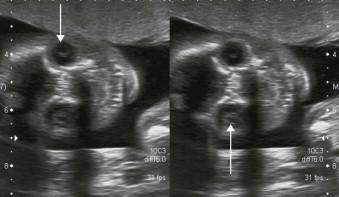
Lens of the eye ( Figure 13-4 ).
Lips ( Figure 13-5 ).
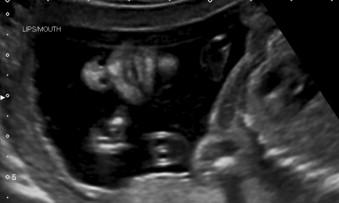
Chin ( Figure 13-5 ).
Nostrils ( Figure 13-5 ).
This plane will allow assessment of the:
Orbits ( Figure 13-6 ).
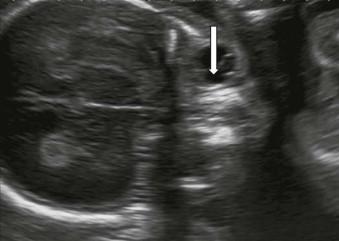
Measurement of orbital diameters ( Figure 13-7 A and B ).
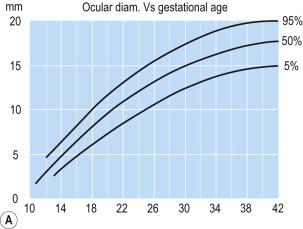
Upper lip.
Maxilla.
From about 16 weeks' gestation, tooth buds will be visualized, mainly those of the four incisor and the two canine teeth ( Figure 13-8 ). The junction between the incisor and canine teeth marks the line of fusion between the primary and secondary palate ( Figure 13-9 ).
Tongue ( Figure 13-10 ).
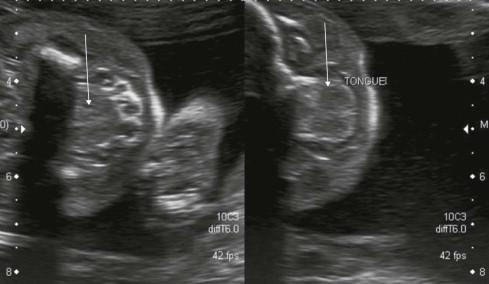
Mandible ( Figure 13-8 ).
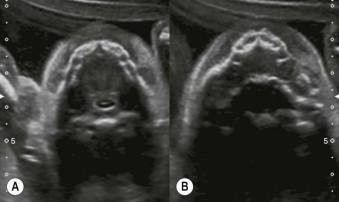
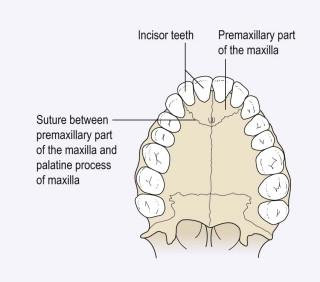
This must be a true midline sagittal view and will allow assessment of:
Forehead ( Figure 13-11 ).
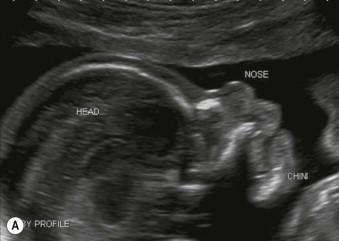
Nasal bone ( Figure 13-11 ).
Alignment of the maxilla and mandible ( Figure 13-11 ).
The sagittal plane is particularly useful in detecting conditions such as micrognathia and frontal bossing. It can also provide additional information in cases of facial clefting.
The sagittal view is also of value in demonstrating the fetal ear and ear lobe morphology can be assessed ( Figure 13-12 ). Low-set ears are best demonstrated in the coronal plane, where the relationship of the ear to the temporal bone and shoulder is easier to evaluate ( Figure 13-13 A and B ).
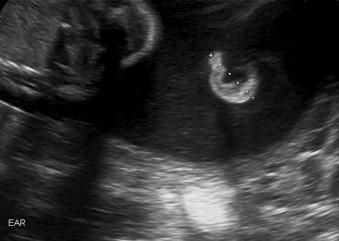

The visualization of the fetal face consists of scanning the face in the three scanning planes as outlined above.
Demonstration of the orbits should reveal that both orbits are of equal size and that there is no evidence of hypertelorism (orbits too far apart) or hypotelorism (orbits too close together). There are charts available for orbital measurements, but as a rule of thumb the interorbital distance is approximately equal to the orbital diameter ( Figure 13-7 A and B ).
Both lenses should always be demonstrated and should appear anechoic, thus excluding congenital cataracts.
Both lips should be visualized using both coronal and transverse scans to exclude facial clefting.
The mandible is best assessed using the profile view to exclude micrognathia. The profile view should form a smooth curve running from forehead, nose, and maxilla to mandible – any break in this smooth curve Figure 13-14 is suspicious and warrants careful assessment. In addition, an unduly flat profile is also worrying and raises the possibility of chromosomal disease.

The presence of both ears should also be established and their relationship to the temporal bone should also be assessed to exclude low-set ears.
With the wider availability of 3D ultrasound machines, the assessment of the face is completed by surface rendering ( Figure 13-15A ), tomographic ultrasound imaging (TUI) of the area of interest in 3D ( Figure 13-15B and Figure 13-15C ) and live scanning using 4D probes. Application of these techniques in assessment of cleft lip/palate is described later in the chapter.
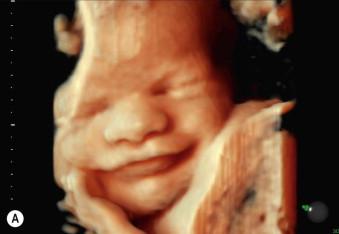
Finally, a full assessment of the fetus should always be carried out as many facial abnormalities are often part of a more complex syndrome.
Visualization of the fetal face can be time-consuming if the baby is not in a good position.
If the fetal head is positioned low in the pelvis or facing posteriorly it may not be possible to obtain coronal or sagittal sections.
If the face is pressed close to the side wall of the uterus there will be difficulties in demonstrating the facial features.
Occasionally the umbilical cord can cause problems in interpretation particularly if the cord is draped over the upper lip in a vertical direction. This can produce the false impression of a facial cleft. Scanning whilst the fetus is opening its mouth or during fetal movement should show the cord moving away from the lip. The other alternative is to use colour flow Doppler in order to demonstrate blood flow within the cord.
Turner and Twining assessed the ability to visualize the fetal face in coronal and sagittal sections and found that at 16–20 weeks, coronal and sagittal sections were obtained in 97% and 95% of cases respectively. However, this fell to 89% and 78% of cases at 35–40 weeks' gestation.
There are many different facial abnormalities and over 150 syndromes involving the head and neck have been described.
A large number of facial malformations can be classified based on pathogenesis, location of the anatomic defect and the structures involved.
Stewart has proposed a classification into four major groups:
Otocraniofacial syndromes, i.e. syndromes predominantly involving the mandible and ear such as Treacher Collins and Goldenhar syndromes.
Facial clefting.
Mid-face syndromes, such as holoprosencephalic malformation syndromes and frontonasal dysplasia.
Craniosynostosis syndromes.
Although this classification will be incorporated into the discussion on facial abnormalities, the ultrasound findings will be described on an anatomic basis: commencing with abnormalities of the mandible, then lips and mouth, nose and orbits, the ears and finally facial anomalies associated with abnormalities of the skull. In this way the discussion will follow a step-by-step approach evaluating the facial structures from mandible to skull in a logical fashion.
A mild form of micrognathia may be a normal variant and is probably overlooked during routine scanning. More marked micrognathia is seen in a large number of chromosomal and genetic syndromes.
The cause of micrognathia is unclear, but as the mandible is formed from the first pharyngeal arch, it is known that damage to the developing pharyngeal arch complex can cause abnormalities of the mandible, maxilla and ear. It has been postulated that ischaemic necrosis, caused by an expanding haematoma arising from the stapedial artery system, which provides the initial blood supply to first pharyngeal arch, can produce under-development of the first arch, resulting in craniofacial microsomia. This is thought to be the aetiology of syndromes such as Goldenhar and hemifacial microsomia (see later section).
Poor outcome has been reported in case series with a less than 20% neonatal survival rate because of associated abnormalities. Vettraino et al. described 15 cases of apparently isolated micrognathia postnatally: 11 were found to have a cleft of the soft palate, seven had mild-to-severe airway obstruction that required intervention and 13 had feeding difficulties. Long-term follow-up revealed that eight of the children were doing well with five reported to have mild-to-moderate developmental delay.
The main cause of death in many cases is related to respiratory difficulties secondary to micrognathia, and to complications secondary to associated malformations. In view of this, it is important to ensure that paediatric support is present at delivery to carry out endotracheal intubation, if required.
Fifty-four syndromes have been listed in which micrognathia is a common feature. Turner and Twining reported nine cases of micrognathia in a series of 24 antenatal diagnoses of facial abnormalities and the majority were associated with either chromosomal disease or skeletal dysplasias. Nicolaides et al. reported 146 cases of facial abnormality detected antenatally and, of these, there were 56 cases of micrognathia. All cases demonstrated other malformations, and chromosomal abnormalities were seen in 66%. Bromley and Benaceraff also found a wide range of syndromes among their series of 20 fetuses with micrognathia ( Table 13-1 ).
| Idiopathic | Mild form |
| Chromosomal disease | Trisomy 18, triploidy |
| Skeletal dysplasias | Camptomelic dysplasia |
| Diastrophic dysplasia | |
| Short-rib polydactyly syndrome | |
| Achondrogenesis | |
| Osteochondrodysplasia | |
| Genetic syndromes | Treacher Collins syndrome |
| Goldenhar syndrome | |
| Hemifacial microsomia | |
| Pierre Robin syndrome | |
| Seckel syndrome | |
| Pena–Shokair syndrome | |
| DiGeorge syndrome | |
| Hydrolethalus syndrome | |
| Roberts syndrome * | |
| Miller syndrome * | |
| Mohr syndrome * |
Micrognathia is a well-documented feature of certain chromosomal abnormalities. Bromley and Benaceraff found chromosomal disease in 25% of their series of 20 fetuses with micrognathia. It is most commonly seen in trisomy 18, where it occurs in up to 53% of cases ( Figure 13-16 A and B ).
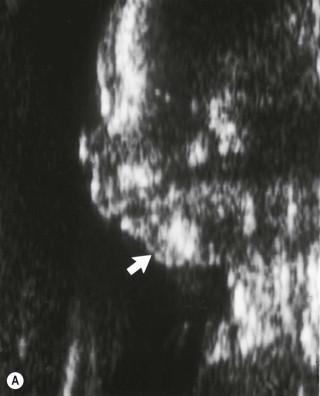
The other major chromosomal anomaly where micrognathia is a feature is triploidy, where it may be seen in over 40% of cases. Micrognathia is occasionally seen in trisomy 13, however, facial clefting is a much more common finding in this autosomal trisomy.
Bromley and Benaceraff reported two skeletal abnormalities in their series of 20 cases of micrognathia, including osteochondrodysplasia and arthrogryposis multiplex congenita. Turner and Twining described three skeletal dysplasias in their series comprising camptomelic dysplasia, diastrophic dysplasia and short-rib polydactyly syndrome ( Figure 13-16 B .
Treacher Collins syndrome-1 (TCS1) is caused by heterozygous mutation in the ‘treacle’ TCOF1 gene located on the long arm of chromosome 5. Treacher Collins syndrome-2 (TCS2) is caused by heterozygous mutation in the POLR1D gene on chromosome 13q12.2. Treacher Collins syndrome-3 (TCS3) is caused by compound heterozygous mutation in the POLR1C gene on chromosome 6. An antenatal diagnosis has been made on several occasions.
The main features of the syndrome affect structures derived from the mesenchyme of the first and second pharyngeal arches:
symmetrical hypoplasia of the malar bones;
antimongoloid slant of the palpebral fissures;
micrognathia;
abnormalities of the ears;
cleft palate is seen in up to 30% of cases;
polyhydramnios may also be an accompanying feature.
Intelligence is normal in most cases.
Antenatal diagnosis in a family at risk is based on the demonstration of micrognathia associated with small malformed ears ( Figure 13-17 ). Meizner et al. reported a case where severe micrognathia was associated with an absent ear on one side and a low-set ear on the other, the fetus also had a facial cleft. With the development of 3D and 4D scanning technology, the antenatal diagnosis has been made with confidence. The phenotypic expression is extremely variable and so subtle cases can be missed. Normal sonographic findings do not completely exclude the syndrome.
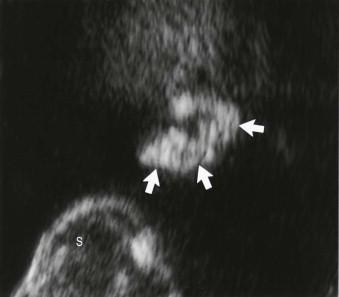
This is a similar syndrome that has an autosomal recessive form of inheritance. This syndrome has also been detected antenatally. The main differentiating features from the Treacher Collins syndrome is the presence of hypoplasia or aplasia of the thumb with hypoplasia or absence of the radius also.
Whereas the Treacher Collins syndrome produces symmetrical deformity of the face, Goldenhar syndrome and hemifacial microsomia present with quite asymmetrical facial involvement ( Figure 13-18 ). Although most cases are sporadic, there is a 2% recurrence risk and a few autosomal dominant cases have been reported. It has been estimated to have an incidence of 1:3500 deliveries.
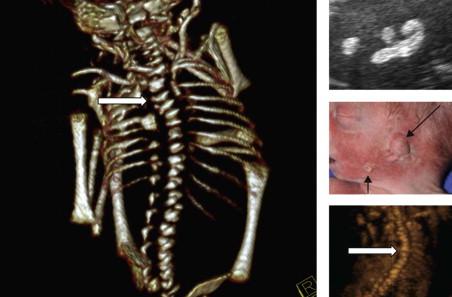
As mentioned earlier all of these syndromes are secondary to underdevelopment of the first and second pharyngeal arches, and produce asymmetrical and, in 70% of cases, unilateral defects.
The main findings in Goldenhar syndrome are:
micrognathia, which may be severe ( Figure 13-18 );
small deformed ears, ( Figure 13-18 );
preauricular tags ( Figure 13-18 );
middle-ear defects which often lead to deafness.
There may be hemivertebrae affecting the cervical spine and a fairly high incidence of cardiac abnormalities, mainly ventriculoseptal defects and Fallot's tetralogy. Severe central nervous system involvement is rare, but hydrocephalus, encephalocoele and mental retardation have been described.
The main finding on ultrasound is micrognathia associated with asymmetrical ear abnormalities. The presence of cardiac abnormalities and the asymmetrical and often unilateral nature of the defect should help to differentiate this syndrome from the Treacher Collins syndrome. In addition, there will be a family history of the defect in the Treacher Collins syndrome, whereas Goldenhar syndrome and hemifacial microsomia are usually sporadic. The prenatal diagnosis has already been reported on 2D, 3D and MRI.
This sporadic syndrome is associated with:
micrognathia;
posteriorly positioned tongue, which can produce airways obstruction in the neonate (glossoptosis);
cleft palate or high arched palate.
The palatal defect is very characteristic as it has an inverted U-shape as opposed to the normal inverted V-shape, and it has been postulated that the defect is produced by the posteriorly positioned tongue, which prevents the normal closure of the palatine shelves that fuse to produce the normal palate (see Embryology section).
The antenatal diagnosis has been described where micrognathia and polyhydramnios were detected at 35 weeks' gestation in a patient who had had a previously affected child. The authors stressed the importance of the antenatal diagnosis in order that paediatric support be present at the delivery to prevent airways obstruction in the neonatal period.
It is of interest that there is the potential for the mandible to catch up in growth to produce a normal appearance in later childhood.
This autosomal recessive condition is characterized by:
micrognathia;
microcephaly;
intrauterine growth retardation;
a receding forehead;
a large beaked nose ;
the ears are often malformed and low-set.
The profile view is very characteristic ( Figure 13-19 ) and this condition is often associated with polyhydramnios. There is moderate shortening of the long bones and there may be clinodactyly of the fifth finger. There is usually moderate-to-severe mental retardation. Majoor-Krakauer et al. reported a recurrence of Seckel syndrome in a patient at 20 weeks' gestation. Ultrasound scanning revealed growth retardation with severe microcephaly, micrognathia and moderate shortening of the long bones. Polyhydramnios was also present. Featherstone et al. confirmed a prenatal diagnosis at 30 weeks in a family without a previous history of Seckel syndrome.
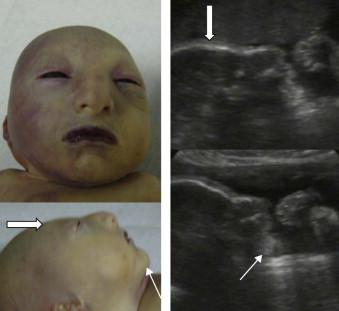
This lethal condition is characterized by, and antenatal diagnosis is based on, the demonstration of:
micrognathia;
camptodactyly;
multiple arthrogryposes;
pulmonary hypoplasia;
polyhydramnios.
The hands show typical flexion of the fingers with overlapping and there is bilateral talipes. Differentiation from chromosomal abnormalities, such as trisomy 18, can be difficult, but the heart is usually normal in Pena–Shokeir syndrome, whereas cardiac anomalies are common in trisomy 18.
Karyotyping is required to exclude chromosomal disease. The outlook is poor, with most babies dying in the neonatal period from pulmonary hypoplasia.
Recurrence risks are high, in the order of 10–15%, and some cases are inherited in an autosomal recessive manner.
This rare condition is thought to be caused by abnormal development of the third and fourth pharyngeal arches.
The syndrome comprises:
facial abnormalities: including micrognathia, low-set abnormal ears, hypertelorism and cleft palate;
cardiac anomalies, mainly persistent truncus arteriosus and interrupted aortic arch but also the combination of Fallot's tetralogy and a right sided aortic arch ( Figure 13-20 A and B );

thymic aplasia or hypoplasia with hypoparathyoidism ( Figure 13-20 A and B ).
About one-third of patients have partial monosomy of the proximal long arm of chromosome 22, i.e. del22q11.
There does appear to be significant overlap of this syndrome with Shprintzen's syndrome (velo-cardio-facial syndrome), which also shows abnormalities of chromosome 22 and has similar clinical features:
micrognathia;
microphthalmia;
microcephaly;
cardiac abnormalities – ventriculoseptal defects, pulmonary stenosis and double outlet right ventricle.
These two diagnoses should be considered when micrognathia is seen in association with cardiac abnormalities. Cytogenetic examination should confirm the diagnosis.
The name of this autosomal recessive syndrome stems from the fact that although micrognathia is a prominent feature the other features are hydrocephalus and polyhydramnios with most cases being lethal. Other possible features include:
hypertelorism;
small or absent thumbs;
postaxial polydactyly in the hands;
preaxial polydactyly is seen in the feet with a markedly angulated extra first toe (characteristic feature);
ventriculoseptal defects may be seen in up to 50% of cases;
an occipital encephalocoele may also be present.
The syndrome can be differentiated from the Meckel–Gruber syndrome as the kidneys are normal.
Using a 2D US sagittal view alone may lead to the misdiagnosis of micrognathia if the plane is oblique and not truly sagittal. A careful review of all the three planes using 3D US multiplanar imaging will detect this error and a true sagittal plane may be obtained by manipulation of all three planes. Using the normative data established by Rotten and co-workers, micrognathia is defined by the ratio of mandibular/maxillary width (Md/Mx of less than 0.785). In the axial plane, the width of maxilla and mandible are measured along a line perpendicular to the sagittal axis at 10 mm from the anterior interosseous border.
Using 2D US, it is also possible to differentiate retrognathia (receding jaw) from micrognathia when the inferior facial angle (IFA) is less than 50 degrees. Inferior facial angle is measured on the facial profile (sagittal view) as the angle between the line perpendicular to the vertical part of forehead, drawn at the level of the synostosis of nasal bones and another line joining the tip of mentum to the more protrusive lip ( Figure 13-21 ).
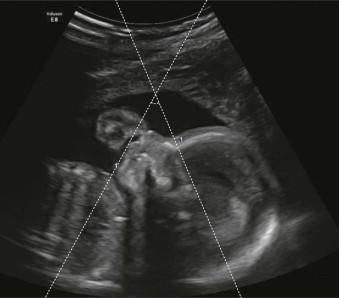
The detection rate for facial clefts, especially cleft lip and or palate (CL(P)) has improved significantly in recent years. Detection of CL(P) is important because nearly half the cases have associated anomalies and 18% of these cases are part of a syndrome or sequence. Even in isolated cases, the perinatal mortality is about three times greater than the background population. The reasons for this have not been clearly identified.
Facial clefting is the most common congenital facial abnormality, with an incidence of approximately 1.3 per 1000 in White populations. There is quite a wide racial variation, with an incidence of 1.5–2.0 per 1000 in Asians and 0.5 per 1000 in Africans. Cleft lip with or without cleft palate occurs twice as commonly in males as females, except in the African population, where males have a very low incidence of cleft lip. Unilateral cleft lip occurs twice as frequently on the left side as on the right and is more common than bilateral cleft lip and palate.
Nyberg et al. proposed a classification of facial clefts into five types ( Figure 13-22 ) based on the ultrasound findings. All the clefts demonstrated will be discussed apart from type 5, which describes bizarre vertical and lateral clefts usually associated with the amniotic band syndrome. These fetuses will usually demonstrate multiple abnormalities including encephalocoeles, anencephaly, limb and body wall defects and scoliosis.
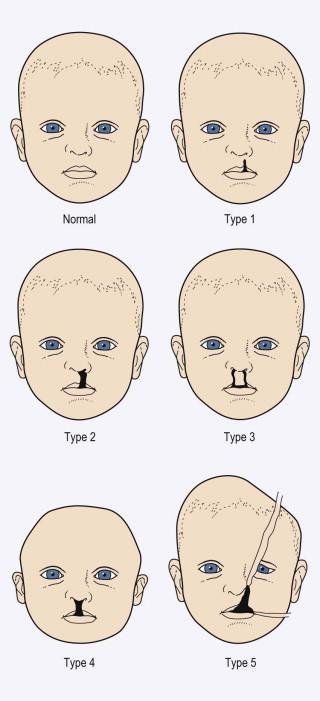
There are four common combinations of facial clefting ( Figure 13-23 ):
Unilateral cleft lip.
Unilateral cleft lip and palate.
Bilateral cleft lip and palate.
Isolated cleft palate.
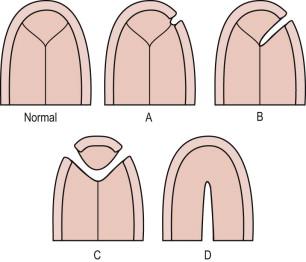
Anterior cleft lip/palate.
Cleft lip (CL)
Cleft lip and alveolus (CLA).
Posterior cleft palate
Cleft in secondary palate (CP).
Both: Cleft lip and palate (CLP).
The distribution of clefts is as follows:
Cleft lip – 25%;
Cleft lip and palate – 51%;
Cleft palate – 24%.
Cleft lip is likely to be severe when there is an associated cleft palate.
Become a Clinical Tree membership for Full access and enjoy Unlimited articles
If you are a member. Log in here